Many Chinese carmakers are exploring flying cars. The Chinese government is in on the flying car game too, sensing an opportunity to leap ahead of the rest of the world, like the country did with EVs and sperm-extracting robots (only $1000 now!). Given how often we’ve heard about these almost mystical machines promising to enter the consumer space, it only makes sense to look at the flying car landscape in China. Let’s talk about policy, regulations, and R&D, and check out some flying machines we’ve seen in China over the years.
Let’s start with a definition. A flying car is a vehicle that can fly and also be used like a car; you can take it any day to go to work or to the grocery store or on a road trip. It doesn’t really have to look like a car, it only has to have the same functionalities. Some people say a flying car should have wheels. That is nonsense (reminds me of those folks who said a car should have windshield wipers, until Hyundai proved them wrong).
Okay, with that out of the way, let’s talk policy.
[Editor’s Note: Just a reminder that Tycho is a world expert on Chinese automotive culture, having lived in the country for years, and having run his own website about Chinese culture. He’s written some insightful stuff for us about China, and we’re glad to see him back after a little break. -DT]
Policy
The government has formulated a policy for flying cars, and in China that means things are about to get very serious. Let me put it simply, based on my extensive understanding of Chinese industrial trends: Policy plan = money = R&D = waste = more waste = 1 million brands = that doesn’t matter = some genuine innovation = the smartest stick around = flying cars for everybody.
Some say the government’s money makes life easy for Chinese manufacturers. Hmm… Imagine a dark pit with thousands of hungry snakes and other evil beasts. Throw in a fat piece of fried beef and see the beasts fight and kill. That’s what happens when the gov’ throws money around. Easy hey? No, it isn’t. It is a fight for survival, and only the strongest will win in the end. True, there is waste and some money may be used for “secondary purposes,” but that’s a price the state is willing to pay to dominate the world.
What does the policy look like?
The flying car policy plan is part of a larger policy plan for the entire transportation sector called “Outline of the Medium and Long-term Development Plan for Scientific and Technological Innovation in the Transportation Sector 2021-2035” (交通领域科技创新中长期发展规划纲要 2021—2035年). This plan is a joint effort by the Ministry of Transport (MOT) and the Ministry of Science and Technology (MOST).
The plan deals with all sorts of transportation-related matters: technology, “intelligent” this-and-that, construction, safety, and green-energy. Flying cars are mentioned in Section 4 (Main Tasks) Article 2 (Improve the level of autonomy in key technologies of transportation equipment). The text says: “Deploy flying car research and development to break through technologies such as the fusion of aircraft and cars, and the free switching between flight and ground driving.”
That single line says a lot. First, it promises government-assisted R&D. Second, China wants to develop a “fusion” vehicle that mixes elements of a car and an aircraft. Third, there must be an easy way to switch between flying and driving, technically and legally. Basically, the Chinese government gives support to, and the green light for, the development and deployment of flying cars. That’s a good start.
Regulations

Policy plans are only useful if they are translted into actual real-world regulations. Flying carmakers are commonly referred to by the Chinese government as Urban Air Mobility (UAM) companies, to distinguish them from traditional airplane and carmakers. In China, the main regulator for airspace is the Civil Aviation Administration of China (CAAC), an agency under the Ministry of Transport (MOT). There is no separate set of rules for flying cars, manned or unmanned. So in theory, that means that every flying car-like vehicle has to go through the entire airworthiness certification, just like a commercial jet. This typically take years and may hurt the growth of the flying car sector.
CAAC is aware of that, and the agency has created an exception for electric vertical take-off and landing (eVTOL) aircraft. Most flying cars under development in China are based on the eVTOL concept. The exception is labeled under “Special Conditions.” A “certification working group” within CAAC can grant a Special Conditions certification to a specific aircraft of a UAM company, and that basically means the aircraft is okay to fly. The first such certification was published in March 2022 for the eHang EH216-S (see below). The process still involved several rounds of safety checks and such, but it is way less complicated and lengthy than a full certification procedure. Xu Huaxiang, chief strategy officer of EHang, told local media: “China’s regulation has a relatively high degree of acceptance of emerging technology products. The release of Special Conditions is a major milestone in the history of global aviation development.”
So China got the policy support and the regulations in place. Is the sector going to boom? Well, it depends on the vehicles, of course.
Now to the Flying Cars!
Time to go for a flight. I’ve put the brands in order of airborne-ness.
Honorary Mention: FAW

This pretty mash of metal is China’s first flying car. It was unveiled by First Auto Works (FAW) in 1957 during a visit by communist leader Bo Yibo to the company’s headquarters in Changchun, Jilin Province. The vehicle was simply called the Flying Car (Fēichē, 飞车). It has an airplane-logo on the hood. It was described as a “flying air cushion car.” Power came from a rotary engine. The developers claimed the car could really “fly” at a height of 1–2 meters above the ground. The prototype had a huge “hole” in the hood and air inlets in the fog lights, both likely a part of the air cushion system.
Design-wise it looks a little bit like the General Motors Firebird III. But no copy-paste here. The Firebird III was built in 1958 and debuted in 1959 — two years after the debut of the Fēichē. FAW seriously planned to produce a small batch of these flying machines, but that never happened. Sadly, during the Cultural Revolution the only prototype of the car was destroyed. And as far as I know there is only this one photo.

The Fēichē was developed by the Changchun Automobile Research Institute, a subsidiary of FAW. This institute was founded in 1950 and was renamed to FAW Technical Center in 1995. The year 1957 was a busy one for the institute. Besides the Fēichē, it also designed the Jiefang CA11A 4-ton truck, co-designed the Yellow River JN150 1.5-ton light truck for Nanjing Automobile, and developed a prototype for China’s first air suspension vehicle.
On top of that, there were organization-matters to deal with. The central government, making plans as always, wanted better automotive research in China. And that meant: merge the institutes! So in 1957, the automobile part of the Automobile & Tractor Research Institute was merged into the Changchun Automobile Research Institute. Happily, the guys of Automobile & Tractor were in Changchun too, so nobody had to leave town. I could write books about the history of Chinese research institutes (I did a lot of reports on the current ones), but that’s for another time.


An institute works with projects, and those have numbers. The Fēichē had project number 601. The institute designed a special logo for the car as well. It looks like an airplane. But that would be too easy; the logo depicts the character 人 (rén) times three. Rén means people, as in People’s Republic. The 3 rens refer to a Chinese idiom “Three people form a crowd” (三人成众, sān rén chéng zhòng), known since the Eastern Zhou Dynasty (770–256 BC).

Most interestingly, the logo was also used on an experimental Hongqi sedan. Hongqi, it may be remembered, is a brand owned by FAW.
Guangzhou eHang Intelligent Technology
Guangzhou eHang Intelligent Technology is an “autonomous aerial vehicle” company founded in 2014 and based in Guangzhou in Guangdong Province. eHang began as a drone maker and has since expanded into flying cars. The company is best known for its proposed flying-taxi service in Dubai, but the plan didn’t pan out. Other such proposed projects in Europe didn’t pass the announcement stage either. But the company didn’t give up. In early 2022, eHang announced projects in Indonesia and in Thailand for sales and operations of eHang vehicles. Let’s see how that ends up. Stock is listed on the Nasdaq but the graph isn’t very pretty. Happily, the flying car is:
eHang 216

The eHang 216 is an electric two-passenger drone with eight propellers on four arms, first shown in 2018. It looks like a spider, or like a nightmare-ish bot from a sci-fi movie. It can allegedly fly fully autonomously or via remote controlled. The 126 is nicely compact, with a width of 5.63 meters and a height of 1.85 meter. Max payload is 220 kilograms, max range is a rather short 30 kilometers, and top speed is 130 km/h. The specs are from eHang’s own website. There are other specs around on the web. eHang says: “All specifications are for reference only and is subject to change without prior notice.” Right.

Legs up! The arms are foldable, so one 216 only takes up 5 m² of parking space.
The eHang 216 has an impressive test-flight record, with flights performed in China, Spain, Indonesia, Norway, Japan, and Quatar, among many others. The most impressive test was in June in Dali, Yunnan Province. Two 216’s flew over water and city with passengers on board.
eHang 216F

The 216F is the firefighting version if the 216, developed to fight the flames in high-rise buildings. The F is equipped with all kind of cool stuff. On the roof is has a launcher for six “fire extinguisher projectiles” that can break through windows and are filled with ABC superfine dry powder, an extinguishing agent. Sticking out from the front is a “high pressure nozzle” that can spray a hundred liters of foam onto a fire. The foam is stored in a compartment under the cabin.
The 216F is not operational yet, and perhaps it won’t be for a while: Flight time is only 21 minutes, which seems barely enough to go up there. Then, it’ll take 120 minutes for a full charge. A battery-swap system would be better on a vehicle like this. It seems eHang is a tad slow with developing new stuff; the 216 first flew in 2018 and the company hasn’t released any new stuff since then. Happily, others make more haste:
XPeng Aero HT

The most fanatic Chinese flying car proponent is XPeng Aero HT, a subsidiary of EV maker XPeng Motor. The car company was founded in 2014 and is fast expanding into Europe. XPeng Motor makes a bunch of cool cars, including the XPeng P5 with an in-build projector and pull-down screen. XPeng Aero HT was born in 2017. HT stands for Huitian, or “Heitech” when branded in English.
Back for a sec to the earlier-mentioned development plan: When it came out, mentioning flying cars and all, Xpeng Aero HT immediately penned a press release saying:
“The intelligent electric flying car produced by XPeng Aero HT is a brand new field. The strategic deployment of flying cars in the plan is very important. The good news affirms the development direction of Xpeng Aero HT. With the support of national policies, it is believed that it will help the development of the flying car industry. It is a guiding document to implement the spirit of President Xi Jinping’s keynote speech at the 2nd United Nations Global Conference on Sustainable Transportation.”
The company’s response once again shows how important these government plans are. Xpeng Aero HT explains it as a direct support for its business and they make sure to mention Xi.
Xpeng’s secured money, too. Last year, the company raised $500 million in Series A capital funding. XPeng claimed it was the “largest single-tranche fundraising to date in Asia’s low-altitude flying vehicle sector.” One of the largest investors is Sequoia Capital China, from the United States. It has invested in all sorts of Chinese tech firms, including Alibaba, DiDi, and DJI, the world largest drone maker which was double-boned by the U.S. government. (That’s enough about DJI for now. It only makes tiny little dronies and no flying cars).
XPeng X1
The XPeng X1 is a single-seat machine with foldable rotors. It debuted on the 2021 Shanghai International Automotive Exhibition. See? An automotive exhibition. So the X1 is a car. Airframe dimensions are 4600mm/3650mm/1500mm. With the rotors folded away, size is only 2600mm/2300mm/1500mm. Empty weight is 260 kilograms and max payload is 160 kilograms. Max altitude is 1 kilometer, endurance is 30 minutes, and top speed 130 km/h (81 mph). The company has made several prototypes and near-production vehicles. It also created a cool video:
To the beach young plane!
Xpeng X2: eight rotors and a roof.
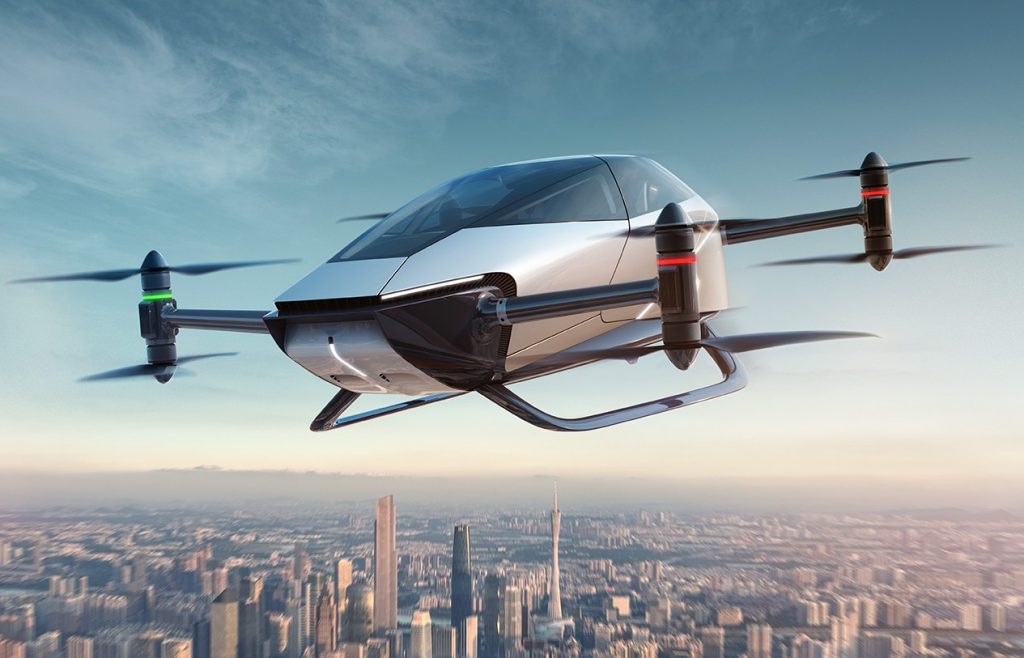
The XPeng X2 is the next step. It is a two seat eVTOL multicopter with foldable rotors and a roof, plus the capability to carry two passengers. The X2 has eight rotors, each powered by its own electric motor. The machine’s maximum speed is 130 km/h (81 mph), cruise altitude is 500 meters, and max altitude is 1 km. The max endurance time is 35 minutes.
The X1 has am empty weight of 560 kilograms and a max payload of 200 kilograms. The fuselage is made of carbon fiber composite. It has two driving modes: manually and autonomous. It is a bit larger than the X1, with airframe dimensions of 4970/4780/1360, all in millimeters. With the rotors away, size is 4790mm/1950mm/1950mm.
So the rotors fold away in a different way than the X1’s. The company has constructed several prototypes for an intensive flight test program. The most famous test, however, didn’t happen in China but in the Middle East.
Dubai test flight
On October 11, at the Gitex Global tech show in Dubai, an X2 prototype made a test flight, with an audience watching. This was the first flight of the X2 outside of China. The X2 carried no passengers. Xpeng Aero HT received a special permit for the flight from the Dubai Civil Aviation Authority.
6th Generation Flying Car: More like a car
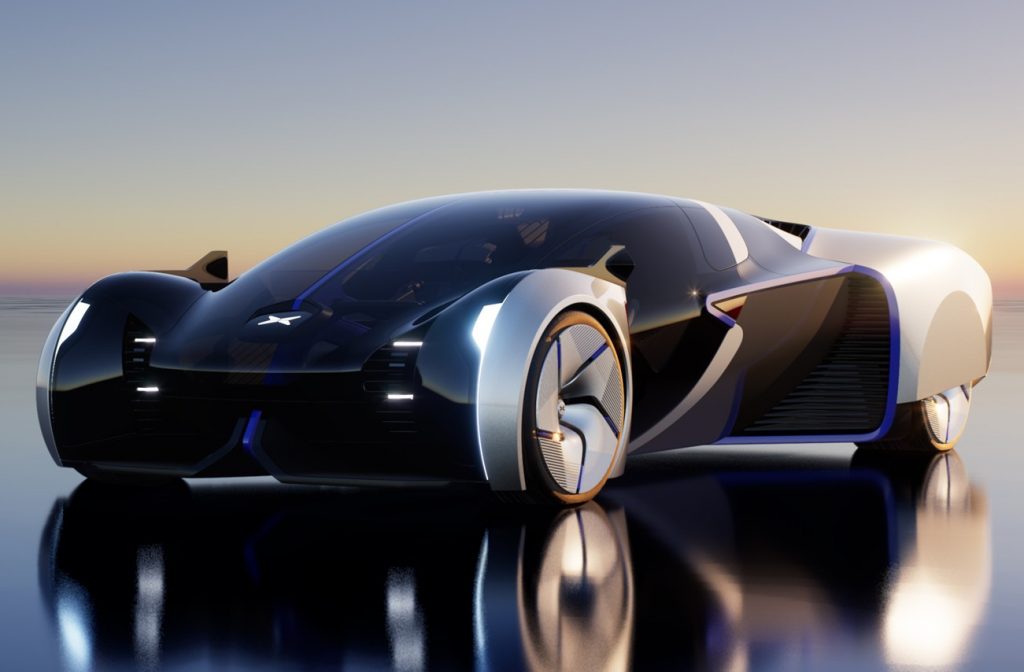
Some may say the X1 and X2 are more like helicopters than cars. I am not one of that some, but I can see the point, if I try really hard. Happily, XPeng has plans for a more car-like flying car. For now, it is called the 6th Generation Flying Car, which is a good name, albeit a little long. It looks like a futuristic super car with extra large wheels. Xpeng Aero HT intends to bring this machine to the market by 2024, with a price of some 1 million yuan ($140.000). It has two rotors that completely fold away behind the car’s cabin. We haven’t seen any real-world demonstration yet but on the video it all seems to fit perfectly well:
Fancy flying car video:
It is a beautiful machine, in concept. But do these rotors really fit inside the vehicle in the real world? XPeng is apparently not sure either, and the real thing will look more like this:

In June 2022, XPeng applied for patent on a rather different design for a flying car. It has a huge box on the roof for the folding rotor system. Not the most aerodynamic solution. The car itself has just two doors, so I assume the rear compartment is used to fit machinery and batteries. Getting a huge car like this into the air will require a lot of power.
And here it is on the the road. Still needs a little work. But we can see the idea. The prototype is based on an XPeng P7, with raised suspension and an extended wheelbase.
XPeng X3

And just when I was finalizing this story XPeng was kind enough to release information about a new flying car: the XPeng X3. That’s why it always takes so long to write stuff about China. It keeps launching new stuff all the time, so a story never ends. The X3 is somewhat similar to the car on the patent pics, with a large box on the roof that holds no fewer than eight rotors. The company also showed a single picture of a prototype on an unmanned test flight.
This stuff suddenly gets very serious. The vehicle had a weight 1,936 kilograms. It has eight rotors on four arms. Each rotor has a diameter of 3.5 meters. During the flight, the vehicle climbed to a height of 10 meters, it hovered and turned, and then returned to earth. The flight took about a minute. XPeng disclosed that the power required for a car to take off vertically is 10-15 times that of the power required for driving on the ground. That’s a lot more.
This is how the unfolding works:
The company said that development is still ongoing, and it didn’t give a timeline for mass production. But it seems sure the project is indeed going forward pretty fast.
Wenzhou Duofu Aviation Industry Group – Pegasus

The story of Pagasus is a curious one, and yet kind of what-you-can-expect. The company Pegasus International Group was founded in 2009 in Australia by Michael Walton Yang. Its first vehicle, the Pegasus S, was unveiled not Down Under but on the 2015 Beijing Aviation Expo. At the same time, the company set up a China subsidiary in Shanghai for the mass production of the S. Hence, Chinese media referred to the Pegasus S as a “domestic flying car.” The owner of that subsidiary promptly bought two S flying cars, which were regularly spotted in a high-end parking garage in that city:

The Shanghai company has since gone bust or dust, and plans for mass production came to nothing. But that was not the end of it. In 2020, Pegasus announced a new joint venture with two Chinese companies: the Duofu Group and Longcheng Feiying Aviation Development. The joint venture will produce the Pegasus S and E in China. Duofu Group is a large holding company with investments in dozens of business, ranging from hotels to nickel mines to fisheries. In June 2022, it acquired Italian helicopter firm Fama, with plans to set-up production and R&D facilities in China. See a trend here?
What makes this extra interesting: According to their Australian website, Pegasus is a member of Aviation Aerospace Australia, an industry association supporting the country’s aviation and aerospace sector. Other notable members include the Australian army and navy, Lockheed Martin, and a bunch of universities and R&D outfits. Nice friends to have indeed.

Thank you Australia! Pegasus is China’s now.
Pegasus S

The S looks very Chinese in concept and execution. It is a 3-wheel vehicle with coaxial rotors. The two-tone paint job and the partially covered rear wheel arches scream speed. Pegasus claimed a flight distance of 900 km/h, a max airspeed of 190 km/h, and a max road speed of 130 km/h. However, the company’s website no longer shows the S as a product, and focuses fully on the E:
Pegasus E
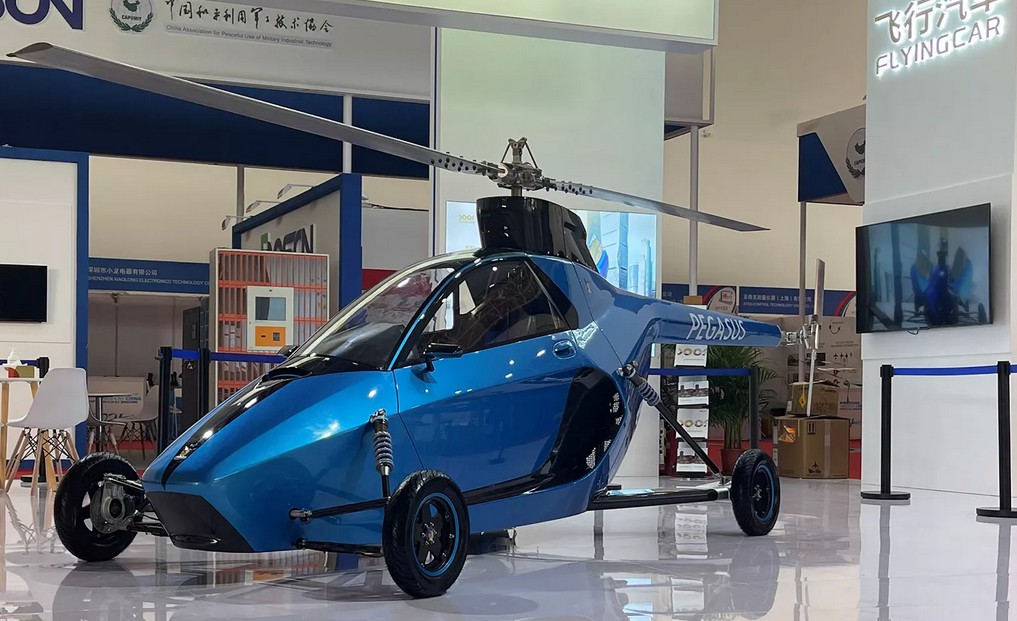
The Pegasus E is more like a small single rotor helicopter with wheels. Power comes from a 160 hp gasoline engine. Top speed on the road is 120 km/h. The rotor diameter is 5.285 meter, about as long as a large SUV. So that should fit in a parking garage. The company claims a “ground to air transition time” of three seconds.
In the air, top speed is 160 km/h and cruise speed 130. Range is 420 kilometers and max altitude is 1,800 meters. The E has only one seat and a max payload of 101 kilograms.
The E really works, as seen in this video (and this one) showing the aircraft during a test flight in China. The pilot has enough confidence to fly it around some tall buildings. The E looks stable and performs in a helicopter-like fashion.
MuYu Aero Technology
MuYu is a VTOL and flying car company founded in 2018, based in Wuxi in Jiangsu Province. It was a subsidiary if AEE Aviation Technology, a Shenzhen drone maker with ties to the military. I say “were” because MuYu Aero appears to be gone. Its website is dead, and there is no recent news. AEE doesn’t seem to be into flying cars, although its site shows one picture of an UAV that seems large enough for two fellows. Still, MuYu’s vehicles are interesting enough for a quick look.
MuYu MY-ABC 750 amphibious flying car

The MY-ABC 750 “amphibious flying car” debuted at the 2018 Zhuhai Air Show. It has a singly propeller at the rear. As the name implies, it can float on water, drive, and fly. And it can take off and land on water and land. ABC stands for Aircraft + Boat + Car. The MY-ABC 750 is equipped with “fully automatic one-button wing folding”. The wings fold over the composite fuselage, behind the cabin. The canopy opens to the front.

The MY-ABC 750 has a 130 hp gasoline engine. The prop has a 1.7 meter diameter. Wing span is 8.5 meters, it is 6.3 meters long and 2.4 meters high. Maximum takeoff weight is 700 kg, with a max load of 300 kg. Takeoff distance is 150 meter on land and 300 on water. Cruising speed is 220 km/h and max flight height is 3500 meters. When airborne, the MY-ABC can fly 1500 kilometers. At the show, the company quoted a price of 5 million yuan. That’s over $700 grand.

The MY-ABC 750 had a car-like interior, with padded floor mats and a nice piece of wood trim on the center tunnel. It has two yokes with buttons on the spoke.
MuYu EV4

MuYu Aero was also working on a much larger vehicle, the EV4 eVTOL. This one was electric, with eight rotors for takeoff and two for propulsion. Max takeoff weight was a claimed 970 kilo. The cockpit has space for four folks. MuYu did a moored test flight but the current state of development is unknown.
Geely
Terrafugia/Volocopter/Aerofugia/AOSSCI/Whatnot more
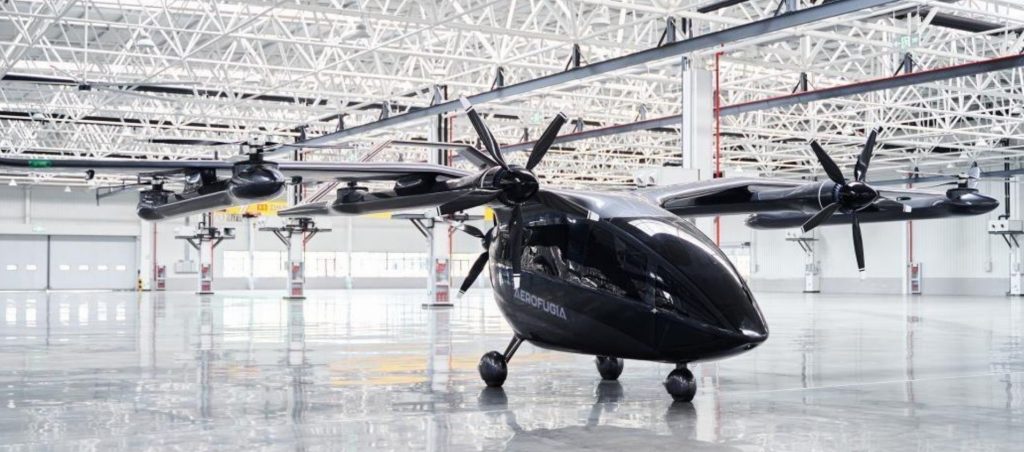
Geely buys and launches brands like there is no tomorrow, or today. Geely follows the same strategy with flying cars. In 2017 Geely bought Terrafugia, a company based on Woburn, Massachusetts. And Terrafugia was cool because… DARPA! In 2010, Terrafugia was awarded DARPA money for Phase 1 of the Transformer (TX), a program developing a military VTOL transporter.
They love that shit in China. Sure Geely will use the tech for a flying Volvo. Anyway. After buying the company, Geely started a slow process of technology transfer and production relocation. In late 2021 Terrafugia laid off most of its staff. The company’s website is basically dead, referring only to a new brand called Commaris. This brand’s main offering is the Seeker, a small unmanned fixed-wing UAV used for inspection and monitoring purposes.
After buying Terrafugia, Geely started founding and merging companies, as Geely is wont to do. A few highlights: In 2017 Geely founded a new China-based company called Aerofugia. This company marketed Terrafugia products in China and developed new aircrafts using Terrafugia’s technology. In 2019, Geely became a “strategic investor” in German eVTOL maker Volocopter, alongside Daimler AG, in which Geely holds a 10% stake.
In 2020 Aerofugia bought with Chinese UAV maker Aossci (Sichuan Aossci Technology). In 2021 Aerofugia setup a joint venture with Volocopter called Volocopter Chengdu Technology. Geely then proceeded to combine all these enterprises under a new company called Geely Technology. Interestingly, Aosscici produces a Chinese version of the Seeker called the X-Chimera, which was spotted in a People’s Liberation Army Air Force (PLAAF) exercise.
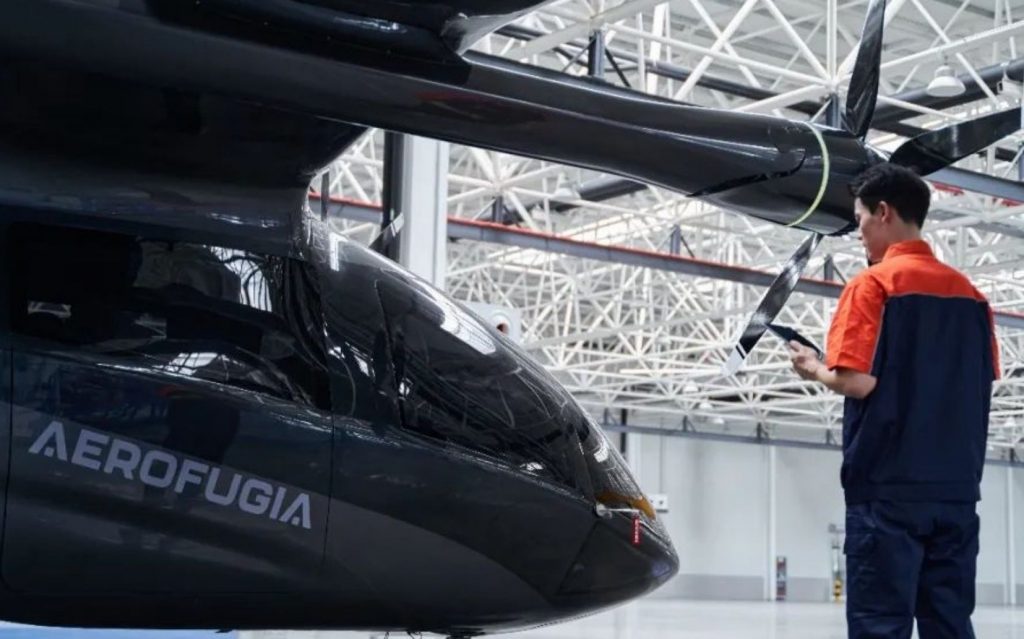
In September 2022, Aerofugia unveiled the TF-2 Flying Car, a five-seat tiltrotor fixed-wing eVTOL aircraft. It has two tiltrotors on the wings and one rotor at the back. The aircraft unveiled was just a prototype. At the time, the company said the maiden flight was scheduled for “the end of 2022”, but not much has been heard from the TF-2 since.
Volkswagen Group China
Volkswagen Group China is the overarching company controlling all of Volkswagen’s ventures in China. It is fully owned by Volkswagen Germany, and its activities include running the SAIC-VW and FAW-VW joint ventures, Volkswagen Anhui, and the import business. Volkswagen was best known in China for the Jetta (there was even a diesel). That was way too old-school for the modern-minded Germans, so VW dumped Jetta in a separate brand in 2019. With that out of the way, the Germans focused on the ID.series of EVs and now, apparently, on flying cars.
Volkswagen V.MO ‘Flying Tiger’

The Volkswagen V.MO is a prototype eVTOL with eight rotors for vertical take-off and landing and two propellers for horizontal propulsion. It has a wing length of 11.2 meters and a wingspan of 10.6 meters. It is nicknamed Flying Tiger, commemorating this year’s Chinese Lunar Year of the Tiger. VW says the first test flight is planned for 2023, and that the eventual production version will be able to carry four passengers over 200 kilometer.
The V.MO is the first vehicle developed under Volkswagen’s so called “air mobility program”, which, according to Volkswagen, “explorer next-generation mobility solutions, including the urban air mobility market and the expansion of urban mobility into airspace.” The company also mentions its mission statement; sit tight, because it is a good one: “In China, for China.” Yeah!
The V.MO was designed by the super duper hip British design firm Tangerine, which also designed a cool train for CRRC Changchun Railway Vehicles. The air-frame for the V.MO was developed by Hunan Sunward Aircraft, a subsidiary of machinery maker Sunward Equipment Group, which does much more in aviation. Hunan Sunward makes all sorts of interesting aircraft, including light sport aircraft, autonomous light aircraft, and military-grade unmanned helicopters.

Thumbs up. They all got two thumbs up except the guy and the gal on the front row on the left and the gal on the back row second from right. These kind of errors annoy me to no end. If they cannot get their thumbs up right, how can they develop a machine as complex as the V.MO?! Get this shit in order Volkswagen, or I won’t be flying in your car!
GAC
GAC is best known for its Trumpchi car brand. But right now it pumps most their money in the new Aion EV brand, which is fast expanding with 600 hp SUVs and sleek super cars. No wonder thus that Aion gets the flying car project.
Aion SP200001

Aion announced the flying car project in June 2022, with an image of something smoky going up. The project’s code name is SP200001. The project has started already; GAC’s R&D center is hiring all sorts of aircraft engineer positions. So we’ll likely see a flying Aion sooner than later.
Total Recap
That was a quick overview of some flying car projects in China. As always, much more is going on, and new flying cars may have taken off by the time you read this. But it is certain that the sector is flying, backed by the government and helped by a relaxed regulatory landscape. Of the current flying car makers, XPeng HT seems the most promising. XPeng is not afraid to experiment and it works quickly. It may yet face more competition as I fully expect more Chinese car companies to join the party. Hopefully Hongqi can give it a go as well. It was the first, after all. Since so much is happening, I hope to do a follow-up of this story in a year from now.
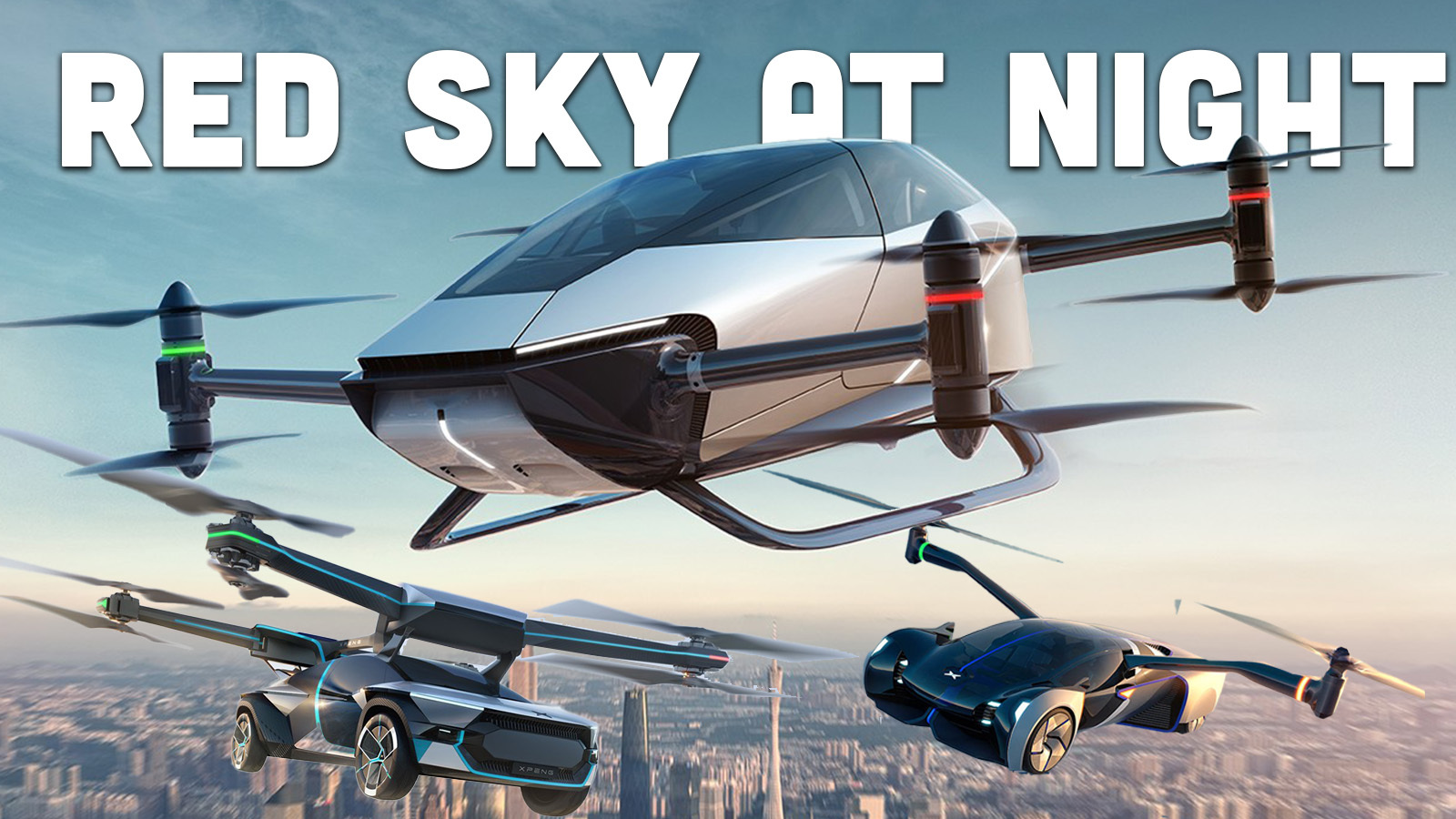






You know you have to have a pilot’s license to fly?
And a commercial pilot’s license to fly with paying passengers?
And certification standards for flying things are even stricter than for cars?
Having said that Paris is determined to have a flying drone taxi service for the 2024 Olympics, it even just launched a flying drone station in anticipation.
The plan is to fly over the road to avoid annoying residents with noise.
It is working with a German maker, which, whisper it quietly, is having difficulty being certified, even though it has flown many times with an actual test pilot on board.
A test flight with big wigs, had spectators watch the take off from 50 metres away, and not just to avoid having expensive hairdos blown away.
Otherwise there are a few actual flying “cars” which are in development, using petrol engines, gearboxes and the like.
And one you can actually buy, a sort of giant quad, which flys with a paramotor sail. But only at max 50 kph.
It’s an interesting article to me not because I think any of these products will ever be a success, but instead because it points out how much China has oriented themselves toward invention and innovation.
It’s like they’re using their interpretation of free markets to take some of the roles that DARPA, NASA and similar government agencies have here.
I’m sure there’s even more going on behind the scenes, but what isn’t guarded as a Chinese state secret is very interesting.
Has anyone figured out traffic rules for vehicles operating in dense proximity in 3D space with no lane markers or street signs?
That’s the first order of business.
My grandmother’s family in western Pennsylvania was the first family in town to get a car. When another family bought a car they promptly ran into each other.
I’m not keen on early adopters figuring it all out over my house.
If there’s one thing you don’t want in a flying car, it’s a deep dive.
You’d leave a hole that’s shallow, but wide.
I hear all the nae sayers about this and many of the points are valid. However, the bigger point in my mind is how this is coming about and that it starts with government support which, while it may be there, I don’t really see that type of support in the west, unfortunately.
I’ve been waiting for my jetpack my whole life, and will never see one, but without people dreaming and funds put toward R&D, nothing that seems outlandish will ever come to fruition. Who knows where this could go and what technologies could come from it.
Are they cars that fly? Not yet, but where else can I read a well written article on the subject? It’s here and I look forward to seeing more.
What are you talking about?Jet packs are already being made.
Look online.The latest i’ve seen uses several micro jet engines.It looks ridiculously cool.
Oh, you meant something that wont ruin your legs and spine when it breaks?Good luck with that! No amount of spending will solve that issue
I’m shocked!Well done china.There are actually some workable designs here.
A reminder: Anything that can’t fly without motors is a non starter. If there’s no autorotate or glide ability, it’s pure deathtrap and can *never* be made safe.
So it’s nice to see ones that work like helicopters or STOL aircraft.Those actually have *some* chance of flying safely.
Now they just have to get through the toughest safety regs ever devised, train normal people as pilots and build lots more expensive take off areas.
Then we’ll have flying cars
-This paragraph read with heavy sarcasm unless it’s not obvious
The top of the article defines a flying car as a vehicle that can both fly like an aircraft and drive like a car, but almost all of the examples shown are basically big drones that you can ride in. eVTOLs are cool and all, but unless they’re also road-legal they are not flying cars. Most of the vehicles shown here don’t even have wheels, just skids.
eVTOLs are neat, and I bet they will even be a thing someday, when battery technology is better. They’ll be very expensive, and will only be able to take off and land from a relatively small number of points compared to where you can park your car, but the concept is too cool to not get built. Current tech doesn’t quite add up to a compelling package, but give it a decade or two. Maybe there will eventually even be enough infrastructure for them to make them semi-practical.
They’re definitely not flying cars in the sense that this article is ostensibly talking about, though. They may be flying cars in the sense that they could lower the barrier to entry to the point where owning and operating one is more like owning and operating a (very expensive) car than an airplane, though. They could conceivably require less fanatical maintenance since electric drives are so simple, and they might be able to do enough of the flying for you to make getting a license for one more like getting your driver’s license than one to fly helicopters. Maybe.
They’re interesting, but they’re not cars.
I want the fantasy Jetsons flying cars, not these drone-based VegoMatic death machines. Frankly, my attempts at flying drones haven’t gone well, and I’m wary of autonomous ai, so I believe I’ll stick to the pavement.
Hey, just cause I’m paranoid doesn’t mean gravity isn’t out to kill me!
Thanks for the article. I had no idea there was this much activity in this arena.
By the look of those exposed rotors I assume there are no safety regulations on these yet
In China? Yeah right. There’s a reason Jason’s Changli was so cheap
Why does ANYONE think flying cars will be a “thing?”
I’m not taking about the technology, or the safety concerns, or the infrastructure. Let’s boil it down to one problem I’ve never heard anyone talk about: Noise.
Amazon delivery drones? Yeah… I want to hear the sound of a dentist drill flying by my house two dozen times a day. And those things are small.
I live 9 miles from a major airport. And there’s constant chatter in my town from NIMBYs complaining about the occasional noise from landing jets 1/3 mile up in the sky when one particular runway is used. (These are the same group of people who have the lawn service arrive with 4 gasoline leaf blowers every other week, but I digress…) Point is, a jet 2000 feet above them gliding toward a runway is still enough to get many people to complain.
Most of these prototypes are vertical take-off. Have you ever heard a quiet helicopter? Me neither. Now multiply that by 1,000. Or more. All. Day. Long. And it’s not like the sounds of cars driving down the street, where the sound will only carry so far because it is muffled by trees, plants, etc. This racket will carry for miles.
Solve the noise problem first.
Im not even sure if this problem can be solved at all, because even with electric engines, the sound of the air moving at very high speeds , and/or the sound of the blades cutting through the air, is noisy enough on its own. That’s why a fan is noisy, it’s not the electric motor, it’s the air moving. Unless we come up with a different way of lifting vehicles (like some sort of anti gravitational device), I don’t see how the noise problem can be solved.
You find the new generation of quiet blades in newer mini-split hvac systems and some automotive cooling fans. They have deeply scalloped trailing edges. My understanding is that this design will not work for lifting blades: those are much narrower due to different missions. Wide ones move air while narrow ones crest lift.
I’m no engineer: salt definitely needed
Well IF they become a thing, I will go back to the practice of law. If a passenger on one of these craft is injured, many times the law suit is regarding quantity of blame on each party, like the passenger/pilot was this negligent, the manufacturer was this other percent of negligent, blah blah.
BUT, if anyone is harmed on the ground, all they need to show is who owned the device that fell on them or their property, and they collect. Think of the 40% of recovery! Lawyers just need to stand in line, file a few docs, and collect 40% of the recovery. We’ll all be rich! (um, “er”)
FYI- you still have a “can we use this photo?” box under the Xpeng AeroHT real life road image.
Shoot. Thank you!